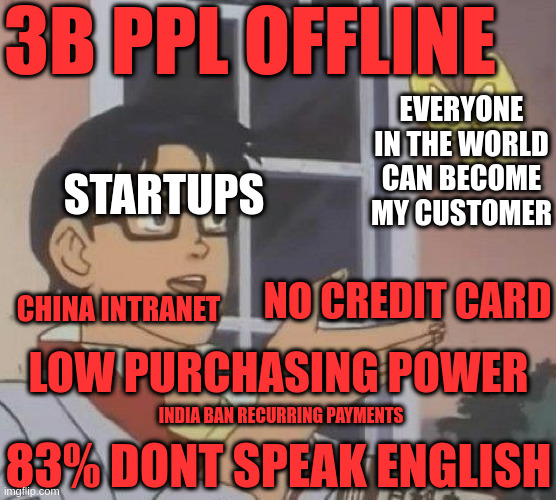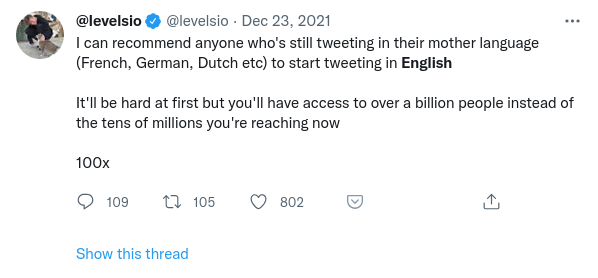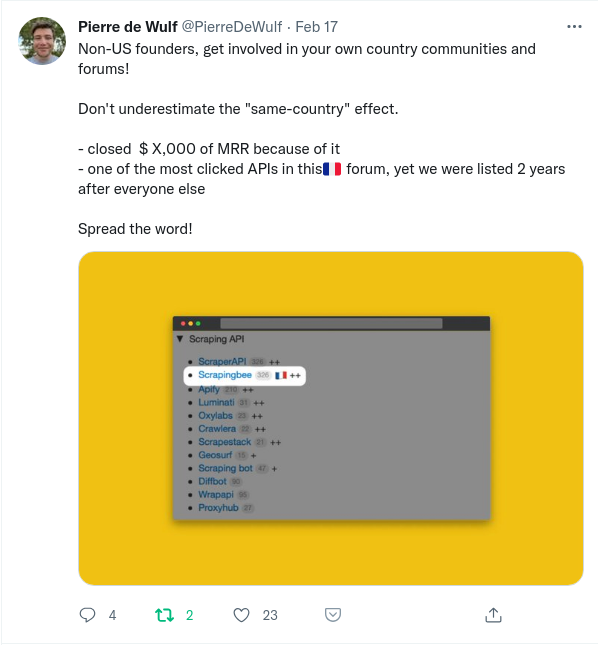25 ideas to optimize your international sales

Fact: 9 out of 10 human beings can’t access or read your website.
- Only 59.5% of human beings have access to the Web (4.66B people - Statista)
- Among those, only 16% can speak English (as a 1st or 2nd language) (VisualCapitalist)
The idea of the Internet being an open place for everyone to share knowledge is very romantic... but idealist.
Like in the physical world, they are borders online. And they are seriously impeding your ability to sell globally. I see 4 main digital borders:
- Infrastructure. A laptop, internet connection, and credit card.
- Language. Whether they can read the what’s on your website or not.
- Money. Can potential users afford your product?
- Culture. How much your product connects with how people think locally.
If all those borders were down, we would have theoretically perfect open market and everyone could become your customer. We’re very, very, far from that.
I have 2 good news for you
You don’t need everyone to be your customer.
As Kevin Kelly said, you only need 1000 true fans to make a living. It’s OK not to be accessible to everyone, especially in the early days.
You can use Pareto’s principle to reap 80% of foreign sales for 20% of the work.
They are a few things you can set and forget to dramatically increase your conversion rate from foreign visitors. I’ve listed here 23 ideas that will remove friction and make your product more accessible to the World.
About me
My name is Jules, founder of Exportator, a Parity Pricing software for Stripe. I’m helping 10s of SaaS increase their MRR by 2-digits by offering VPN-free, optimally priced, regional pricing. I got started 1 year ago with this IndieHacker post.
Should you consider internationalization?
If you’re selling a digital product, yes.
An extra copy of a digital product costs almost nothing to produce. International sales have lower margins (regional discounts, conversion fees, translations costs, etc.), but the sales volume they give you access to are too big to ignore. That how Spotify conquered to world, and it’s working with small companies too.
If you have no traction, wait.
Now is the time to focus on the smallest niche possible and talk with your users. Come back when you’ve found Product-Market Fit.
Signals you should consider opening new markets
Traffic. Study your Analytics; If you notice a significant share from somewhere, investigate why. Are local influencers talking about you? Why? Reach out to them, consider affiliate programs.
New competitors. If copycats are appearing in other countries, you’re failing at satisfying their local markets. Perhaps it’s a money issue and you should consider parity pricing. Perhaps it’s a language thing and you should consider translation.
Customers asking you for regional discounts. For one asking, how many are just leaving?
Ranked from 🟩 easy to set up and maintain, 🟧 to intermediate, 🟥 and hard.
Infrastructure 🔌
Connectivity, payment methods, and local politics have a huge impact on your foreign sales. It’s a global challenge but they’re still things you can do.
- 40% of the worldwide population is offline (Statista).
- 1B people have <20mb/s broadband access (10x slower than US average) (WPR).
- 2.8B credit cards in use worldwide, of which 1.06 billion in the US (Spendesk).
- China or North Korea’s digital borders are hermetically closed.
- India is enforcing protectionist laws by restricting recurring payments to foreign companies (TechCrunch).
Things you can do to increase your international sales
- 🟩 Segment your users’ origin. Seems obvious but if you are to improve your foreign sales, you need to be able to differentiate who’s who. Ask users where they’re from early on.
- 🟩 Make your site lighter. Not everyone is on 5G or fiber. Consider removing data-heavy and computing-power intensive elements from your site. I love websites such as Flurly because of their simplicity.
- 🟩 Simpler design. Not everyone has the latest MacBook retina screen: Subtle gradients and colors won’t be noticed on a CRT screen running Windows XP.
- 🟩 Promote annual plans. When payment is an issue, offer to sell annual plans to remove friction. By removing 11 out of the 12 painful payment processes, you’re saving you and your customers time and efforts. You can do this by automating on-site promotions, or by regularly sending segmented emails. It’s a good way to bypass India’s ban on recurring payments.
- 🟧 Consider alternative payment methods. Credit cards, Paypal, SWIFT payments, digital wallets, and crypto payments can be solutions to potential customers’ payment issues. Listen to user’s requests and consider integrating new payment methods, or having articles guiding customers through manual wire transfer or crypto-payments.
Language 🗣️
Translation is the tip of the Internationalization iceberg. But it’s resource-intensive.
- Native English speakers make for 4.61% (360M) of the world pop (Ethnologue).
- Including second-language speakers, that’s 17.3% (1.35B people).
- India+Nigeria+Philippines account for 460M English speakers. But their purchasing power is on average 60% lower than USA’s.
- Translating to Spanish+Portuguese+Arabic opens you a 780M people market (Internet World Stats).

Things you can do to increase your international sales
- 🟩 Use English. English is the most widely talked language on the Internet. It’s also the language of the richest audience. Unless your product targets a country for good reason (local services, laws, specific audience), using English will right off the bat expose you to the largest audience.
- 🟩 Use simple English. Think Donald Trump simple. The simpler you write, to easier it is for a global audience to understand you. If you’re a native speaker, you can also use Grammarly to simplify your articles.
- 🟩 Icons, emojis, good design. Use basic words and icons to make your software accessible to most. Good software requires no documentation. Good design can require very few words.
- 🟩 Regional affiliates. Get foreign influencers to promote your product in languages you don’t master.
5 tips if you decide to go for translation
- 🟧 Minimal translation. Translate the hard-coded bits of your apps only. Consider tools like i18n for Rails.
- 🟧 Translate main pieces of content. Use sub-directories (www.mysite.com /fr ) and translate your homepage and key pieces of content. Pros: More traffic and sales. Cons: Support with non-English speakers will be awkward.
- 🟥 Full translation. Translate every newsletter, promo, etc. for international audiences. The best results, but obviously very resource-intensive, and slows down the speed of execution.
- 🟥 Localize domains. For optimal SEO and authority, bigger companies can even fully localize in a country (www.mysite. fr ). Pinterest had massive success unlocking international growth by switching domain structure.
- Beware of automated translation. From a car-rental company brochure in Tokyo, Japan: “When passenger of foot heave in sight, tootle the horn. Trumpet him melodiously at first, but if he still obstacles your passage then tootle him with vigor”. Tools like lokalise make human translation as easy to set up as automated translation.
- Infoproducts. If you’re selling info products, translation costs are one-time investments that can open significant new markets. Look at your analytics, talk to your audience, see if there’s an opportunity somewhere. If your content is text, consider translation. If it’s video, consider subtitles.
- Pick your fight. Translation doesn’t mean you have to support all 6500 currently spoken languages in the world (though that would be pretty badass). Save resources by picking the one(s) language(s) that will give you the best ROI.
Money 💸
US$30 might not be much to you. But to someone else, it a week’s work salary.
- Average hourly wage in the 🇺🇸 USA: US$16,36 vs US$9.38 in 🇧🇷 Brazil (-43%) (Statista/SE)
- Developer average hourly wage in the 🇺🇸 USA: US$35 vs US$5.64 in 🇮🇳 India (-85%)
- 90% of the world’s population purchasing power is lower than the US average (WorldBank)
Things you can do to increase your international sales
- 🟩 Cosmetic localization. Use your visitor’s location to show them a currency they understand: “$20” becomes “1500₹”.
- 🟩 Give out Parity discounts. Make extra sales by granting a discount to customers asking you for a PPP discount. Use the Parity Pricing Calculator to estimate the optimal discount for the country the person is from.
- 🟩 Automate Parity pricing. Display on your pricing page that you’re offering a Parity discount; By giving it visibility, more people will use it and talk about it. If you’re worried about potential cheaters, solutions like Exportator perform a proxy-check and offer unique promo codes.
- 🟩/🟧 Permanent regional pricing. Make regional pricing a full-time thing for people to see your price adapted to their currency and purchasing power. Ideal for “at scale” companies like Spotify or Netflix to implement themselves for the long term in new markets.
- 🟩 Promote your international pricing. Use newsletters such as ParityPricingPlaza to promote to a non-Western audience hungry for affordable alternatives. Segment and promote your new pricing to your own users.
Culture 🌍
The last and most subtle wall between you and your foreign market is the culture. It requires significant resources to create, and even more to maintain.

Things you can do to increase your international sales
- 🟩 Love your home country. At my previous start-up, which was based in France, roughly 20% of our traffic and revenue came from France. That’s because, during the first years, the founders had scoured the country doing talks and courses, building little by little an audience. After a few years, it solidified into a solid market 5 or 6 times bigger than countries similar in size, like say, Germany, but with which we had no connection. Cater to your home country, get to know influencers, do local talks and podcasts. Having a culture and native language in common creates a deeper bond that’s valuable to you as a Indiehacker.
- 🟩 Celebrate foreign bank holidays. Chinese New Year, Diwali, Hanukkah, can become occasions to turn a significant chunk of regional traffic into paying customers. Not only will it grow your sales but acknowledging and celebrating undervalued segments of your visitors will increase loyalty to your brand. A valuable low-hanging fruit is for you to schedule those events and email each segment with a promo code.
- 🟧 Names that backfire. The US company Puff exported its tissues to Germany using the same brand name, not knowing “puff” means brothel in German slang. It’s difficult checking every word and sounds in every language. But ask Quora or Reddit communities to check your name ideas to dodge some bullets.
- 🟧 Cultural offense. This Chinese washing powder ad is obviously racist to you (hopefully) but not to everyone. Mentions of pork, alcohol, days of the week, colors, and many other things, can be viewed as offensive in other countries. That’s why Black Friday is called White Friday in the Arab world. Humour is hard to translate so the wider your audience the more PG13 you need to be.
➡️ How do you tackle internationalization? What are your hacks?
➡️ If you’re from an emerging country, what is painful for you when buying digital products?
I hope this article gave you some perspective on the topic of internationalization. Everyone doesn’t need to be your customer, but neglecting your international sales is just as bad.
Take a few steps early on to make it easy for the global audience to become your customer. Results will compound over time.
I spent the last year working on Exportator. An easy to set up, low-maintenance, efficient, regional pricing solution because it’s a true 80/20 low hanging fruit of your international growth and I really recommend you try it for a month. I actually bet you’ll start making extra sale from day 1.
Read more about parity pricing on my Twitter.
Thanks Austin for asking me to turn my answer into a post!

Insightful post Jules.
I am building an open-source internationalization (eco) system for software called inlang -> https://inlang.dev .
I assume you used lokalise. Any downsides/pitfalls I should be aware when building inlang?
Dope man! I'm not using anything because translation would be too much work for me as a solobootstrapper, but I'll consider inlang in the future.
Nothing comes to mind regarding downsides/pitfalls. I'll get back to you if something comes to mind.